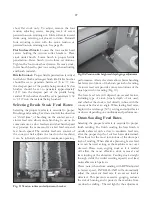
4
SAFETY RULES:
1.
KEEP GUARDS IN PLACE and in working order.
2.
REMOVE ADJUSTING KEYS AND WRENCHES.
Form habit of checking to see that keys and adjusting
wrenches are removed from tool before turning it on.
3.
KEEP WORK AREA CLEAN. Cluttered areas and
benches invite accidents.
4.
DON'T USE IN DANGEROUS ENVIRONMENT.
Don't use power tools in damp or wet locations, or
expose them to rain. Keep work area well lighted.
5.
KEEP CHILDREN AWAY. All visitors should be
kept safe distance from work area.
6.
MAKE WORKSHOP CHILD PROOF with padlocks,
master switches, or by removing starter keys.
7.
DON'T FORCE TOOL. It will do the job better and
safer at the rate for which it was designed.
8.
USE RIGHT TOOL. Don't force tool or attachment to
do a job for which it was not designed.
9.
USE PROPER EXTENSION CORD. Make sure
your extension cord is in good condition. When using an
extension cord, be sure to use one heavy enough to
carry the current your product will draw. An undersized
cord will cause a drop in line voltage resulting in loss of
power and overheating. Table A (on the next page)
shows the correct size to use depending on cord length
and nameplate ampere rating. If in doubt, use the next
heavier gage. The smaller the gage number, the heavier
the cord.
10.
WEAR PROPER APPAREL. Do not wear loose
clothing, gloves, neckties, rings, bracelets, or
other jewelry which may get caught in moving
parts. Nonslip footwear is recommended. Wear
protective hair covering to contain long hair.
11.
ALWAYS USE SAFETY GLASSES. Also use
face
or dust mask if cutting operation is dusty. Everyday
eyeglasses only have impact resistant lenses, they are
NOT safety glasses.
12.
SECURE WORK. Use clamps or a vise to hold
work when practical. It's safer than using your
hand and it frees both hands to operate tool.
13.
DON'T OVERREACH. Keep proper footing and
balance at all times.
14.
MAINTAIN TOOLS WITH CARE. Keep tools sharp
and clean for best and safest performance. Fol-
low instructions for lubricating and changing ac-
cessories.
15.
DISCONNECT TOOLS before servicing; when
changing accessories, such as blades, bits, cut-
ters, and the like.
16.
REDUCE THE RISK OF UNINTENTIONAL STA-
TING. Make sure switch is in off position before
plugging in.
17.
USE RECOMMENDED ACCESSORIES. Consult
the owner's manual for recommended accessories. The
use of improper accessories may cause risk of injury to
persons.
18.
NEVER STAND ON TOOL. Serious injury could
occur if the tool is tipped or if the cutting tool is
unintentionally contacted.
19.
CHECK DAMAGED PARTS. Before further use of the
tool, a guard or other part that is damaged
should be carefully checked to determine that it
will operate properly and perform its intended
function - check for alignment of moving parts,
binding of moving parts, breakage of parts,
mounting, and any other conditions that may
affect its operation. A guard or other part that is
damaged should be properly repaired or re-
placed.
20.
DIRECTION OF FEED. Feed work into a blade or
cutter against the direction of rotation of the blade
or cutter only.
21.
NEVER LEAVE TOOL RUNNING UNATTENDED.
TURN POWER OFF. Don't leave tool until it comes to a
complete stop.
Some dust created by power sanding, sawing, grinding, drilling and other construction activities contain chemicals known to cause cancer,
birth defects or other reproductive harm. Some examples of these chemicals are:
•
Lead
from lead based paint.
•
Crystalline silica
from bricks, cement, and other masonry products.
•
Arsenic
and
chromium
from chemically treated lumber.
Your risk of exposure varies, depending on how often you do this type of work. To reduce your exposure to these chemicals, work in
a well-ventilated area and work with approved safety equipment, such as face or dust masks that are specifically designed to filter
out microscopic particles.
Proposition 65 Warning
Содержание SuperMax 19-38 Combo
Страница 1: ...19 38 Combo Brush Drum Sander Owner s Manual Lagunatools com SKU 219383...
Страница 31: ...31...
Страница 34: ...34 34...
Страница 36: ...36...
Страница 39: ...39...





































